Plastic extrusion systems are the cornerstone of modern plastic manufacturing, transforming raw resin into a vast array of products we use daily. From pipes and profiles to films and sheets, these systems are crucial in producing consistent, high-quality plastic items efficiently. Understanding the complete plastic extrusion system is essential for manufacturers, engineers, and anyone involved in the plastics industry.
A plastic extrusion system is more than just an extruder; it’s a comprehensive setup that includes various components working in harmony to convert plastic pellets into finished products. This article will guide you through each stage of a complete plastic extrusion system, providing insights into how these components work together to create the plastic products we rely on.
1. Raw Material Handling: The Foundation of Quality
The journey of plastic extrusion begins with proper raw material handling, a critical yet often overlooked aspect of the plastic extrusion system.
Resin Storage and Delivery Systems
- Silos and Hoppers: Large-scale plastic extrusion systems often use silos for bulk storage of plastic resins. These are connected to the production line via pneumatic conveying systems.
- Vacuum Loaders: These devices transport resin from storage to the extruder hopper, ensuring a consistent supply of material.
- Dehumidifying Dryers: Many plastics are hygroscopic and need to be dried before processing. Dehumidifying dryers remove moisture from the resin to prevent defects in the final product.
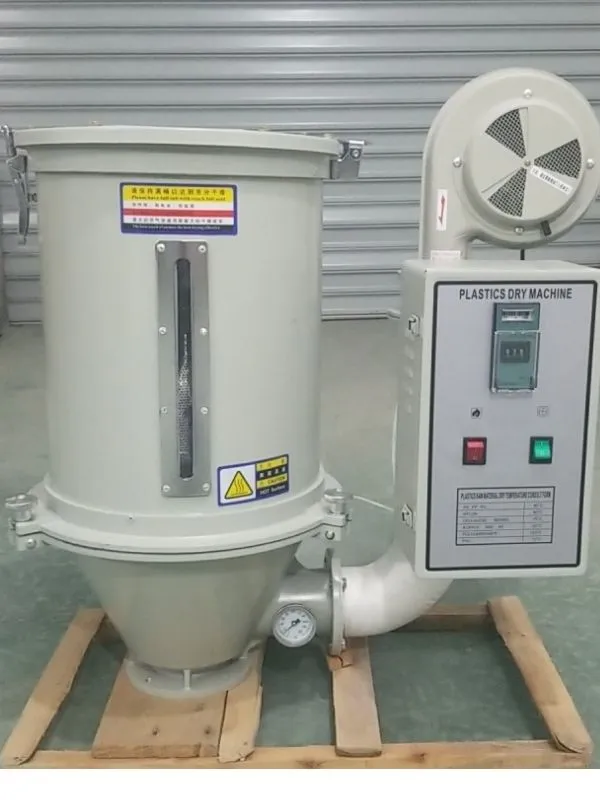

Blending and Mixing Equipment
- Gravimetric Blenders: These precise machines blend different resins or additives according to specific recipes, ensuring consistent material composition.
- Color Masterbatch Feeders: For adding colorants to the plastic, these feeders accurately dose masterbatch into the main resin stream.
Proper raw material handling in a plastic extrusion system not only ensures consistent product quality but also optimizes material usage and reduces waste.
Example: PP Pipe Production
In a polypropylene (PP) pipe manufacturing plant, the raw material handling system might include a large silo for storing PP resin, connected to a dehumidifying dryer to remove any moisture.
A gravimetric blender would precisely mix the PP with UV stabilizers and other additives before feeding the mixture into the single screw extruder. This careful preparation ensures the final pipes have consistent strength, durability, and resistance to UV degradation, which are crucial for applications like water supply and drainage systems.
2. The Extruder: Heart of the Plastic Extrusion System
The extruder is the central component of any plastic extrusion system, responsible for melting, mixing, and pressurizing the plastic resin.
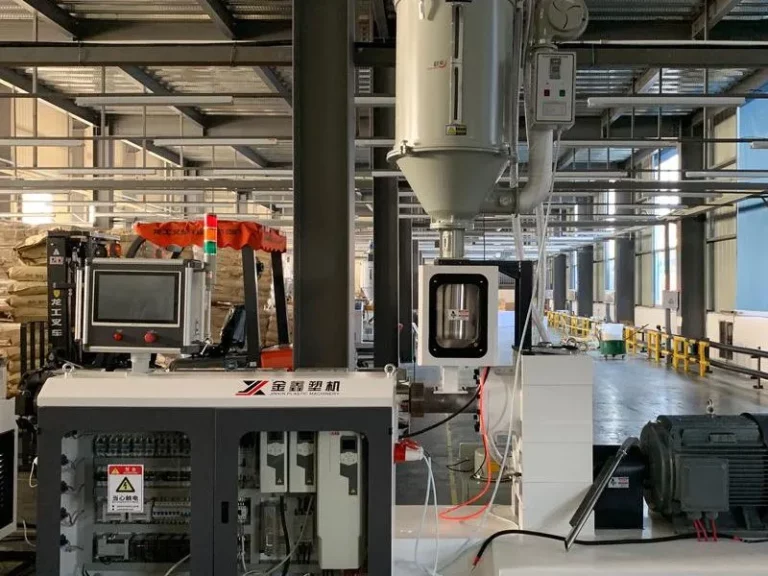
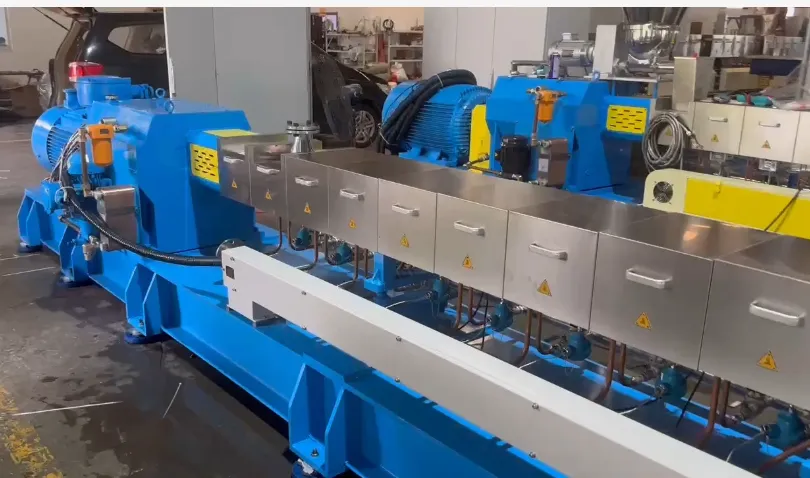
Single Screw vs. Twin Screw Options
- Single Screw Extruders:
- Most common in plastic extrusion systems
- Ideal for processing thermoplastics with good melting properties
- Simpler design, easier to maintain
- Twin Screw Extruders:
- Better mixing capabilities
- Suitable for materials that are difficult to process or require intensive mixing
- Often used for compounding or processing heat-sensitive materials
Key Components of the Extruder
- Hopper: Feeds plastic resin into the extruder barrel.
- Barrel: Houses the screw and provides heat to melt the plastic.
- Screw: Rotates to convey, melt, and mix the plastic material.
- Different screw designs for various materials and applications
- Die: Shapes the molten plastic into the desired profile.
- Custom dies for specific product shapes

The extruder’s performance is crucial to the overall efficiency and quality output of the plastic extrusion system. Proper selection and maintenance of the extruder components are essential for optimal operation.
Example: Film Extrusion
In a plastic film extrusion system, a single screw extruder might be used with a specialized film die. The screw design would be optimized for the specific polymer being used, such as TPE for medical tourniquet. The die would have a flat or annular opening to create the desired film thickness.
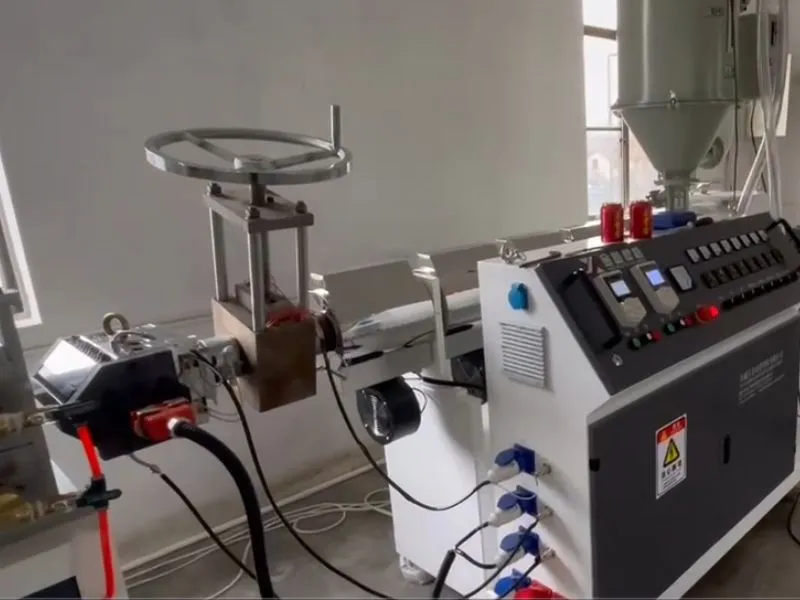
3. Cooling and Shaping: Solidifying the Vision
After exiting the die, the molten plastic needs to be cooled and solidified into its final shape. This stage is critical for maintaining product dimensions and surface quality.
Water Baths
- Cooling Tanks: Long tanks filled with water for rapid cooling of extruded products.
- Spray Cooling: For products that require more gentle cooling to prevent warping.
- Temperature Control: Precise control of water temperature for optimal cooling rates.
Air Cooling Systems
- Air Knives: Direct high-velocity air onto the product surface for cooling and drying.
- Cooling Towers: For closed-loop water cooling systems to maintain consistent temperatures.
Calibration Equipment
- Vacuum Sizing Tanks: Maintain the shape and dimensions of hollow profiles as they cool.
- Sizing Plates: Guide and shape the product as it cools to ensure consistent dimensions.
- Ultrasonic Measurement Devices: Continuously monitor product dimensions for real-time adjustments.
Proper cooling and shaping are essential in a plastic extrusion system to ensure the final product meets specifications and quality standards.
Example: PA Tubing Production
In the production of polyamide (PA) tubing for automotive fuel lines, the extruded tube would pass through cooling baths.
Precision vacuum sizing equipment would maintain the tube’s exact diameter as it cools, ensuring it meets the strict dimensional tolerances required for automotive applications.
The cooling process is carefully controlled to achieve the right balance of flexibility and barrier properties in the final product.
4. Downstream Equipment: Finishing Touches
Downstream equipment in a plastic extrusion system handles the product after it has been extruded and cooled, preparing it for final processing or packaging.
Puller Systems
- Caterpillar Pullers: Use rubber belts to grip and pull the extruded product at a consistent speed.
- Wheel Pullers: Suitable for delicate products that require gentle handling.
- Servo-Driven Pullers: Offer precise speed control for maintaining product dimensions.
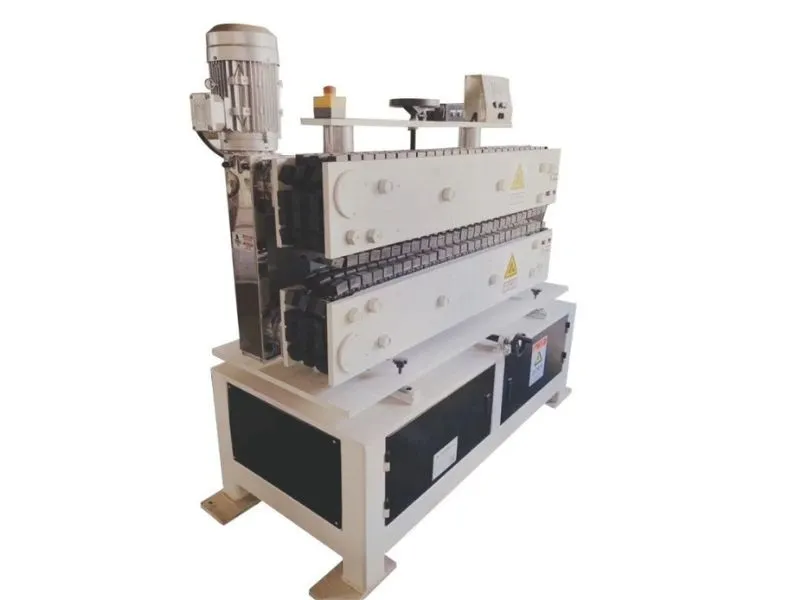

Cutting and Sawing Machines
- Flying Cutters: Cut products to length without stopping the extrusion process.
- Planetary Cutters: Ideal for cutting pipes and profiles with thick walls.
- Laser Cutting Systems: For precise, clean cuts on specialized products.
Coiling Systems
- Automatic Coilers: Wind flexible extruded products like pipes or cables into coils.
- Accumulation Tables: Allow continuous extrusion while changing coils.
- Traverse Winders: Ensure even distribution of product on the coil.
Effective downstream equipment ensures that the extruded product is handled efficiently and prepared for further processing or shipping, completing the plastic extrusion system’s production cycle.
Example: Cable Jacketing
In a plastic extrusion system for cable jacketing, the extruded jacket would be cooled and then passed through a series of dancer rollers to maintain consistent tension.
A high-precision laser marking system might then print product codes or length markers on the cable.
Finally, a servo-controlled coiler would wind the finished cable onto large spools, automatically switching to a new spool when the current one is full, allowing for continuous production.
Conclusion: The Synergy of a Complete Plastic Extrusion System
A well-integrated plastic extrusion system is a marvel of engineering, combining mechanical, thermal, and control technologies to transform raw plastic into valuable products. From raw material handling to the final quality control checks, each component plays a vital role in the success of the extrusion process.
As we look to the future, plastic extrusion systems are evolving to meet new challenges:
- Sustainability: Increased focus on recycling and using bio-based materials.
- Industry 4.0: Greater integration of AI and machine learning for process optimization.
- Energy Efficiency: Development of more energy-efficient components and processes.
- Flexibility: Systems capable of quick changeovers to meet demand for smaller batch sizes.
Understanding the anatomy of a complete plastic extrusion system is crucial for anyone involved in plastic manufacturing. It enables informed decision-making in equipment selection, troubleshooting, and process optimization. As technology continues to advance, staying updated on these developments will be key to maintaining a competitive edge in the dynamic world of plastic extrusion.
By considering each component of the plastic extrusion system and how they work together, manufacturers can optimize their processes, improve product quality, and stay ahead in an increasingly competitive market. Whether you’re producing pipes, profiles, films, or any other extruded plastic product, a comprehensive understanding of your plastic extrusion system is the foundation of success.